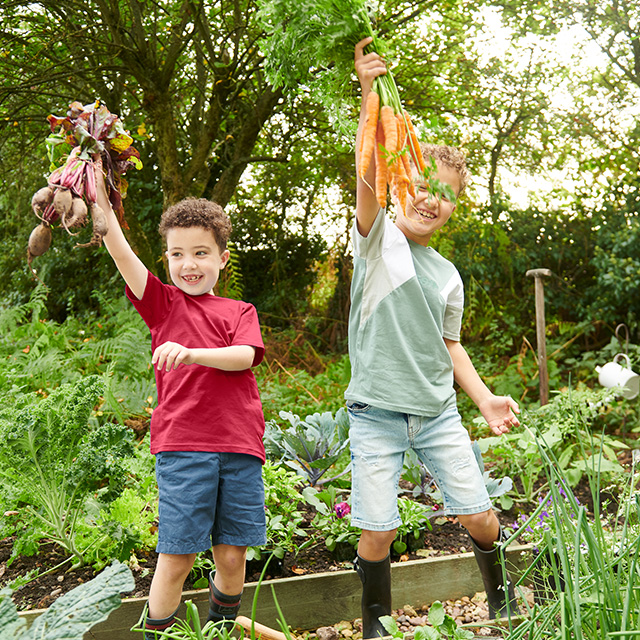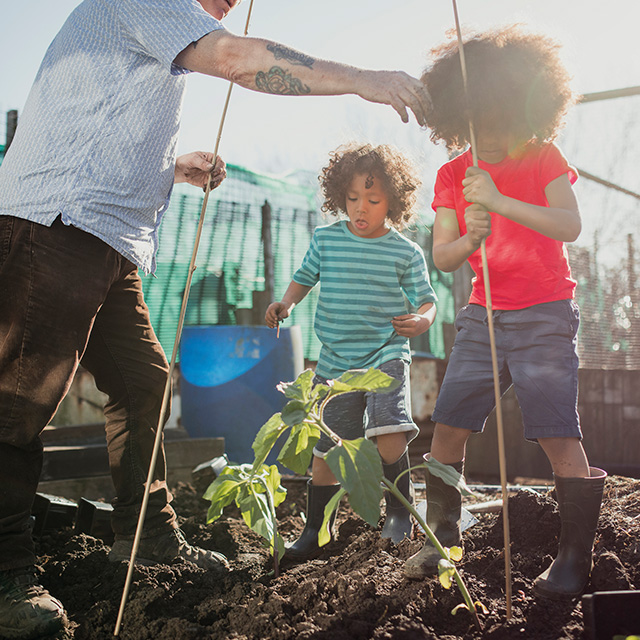Beginner’s guide to starting a vegetable garden
Having your own veg garden is a satisfying and delicious way of growing your own food, helping you eat healthier and save some money in the process! It only takes a few steps to get started, so no matter the size of your garden, here’s our guide to starting a vegetable garden of your own.
 By Alex
By Alex- 17th June 2024
- 8min read
- This blog was updated on 23rd June 2025
Start small
You don’t need acres of land to grow your own veg – you can get started by using a small section of your existing flowerbed or your lawn, as long as it gets decent sunlight.
You don’t have to dig up your lawn to make it into a veg patch – you can use the popular ‘no dig’ technique! Lay down a layer of cardboard to stop weeds before covering with an inch or 2 of compost. Nature will do the rest!
You don’t even need a garden to start your own veg patch; plants like tomatoes, runner beans and potatoes can grow quite happily in plant pots, as will many herbs. If you only have a patio or a balcony, you can still eat delicious homegrown veg!
There will be plenty of trial and error when it comes to starting your veg garden, so start small and upgrade as your confidence (and your veg patch) grows.
Get ahead with a greenhouse
The majority of your vegetable seeds will do better when they’re started indoors. This provides them with a warm and toasty environment to germinate without the risk of being frozen, or nibbled by pesky pests. You can start your seeds in seed trays on a sunny windowsill, but a worthwhile vegetable garden upgrade is having your own greenhouse!
A greenhouse will protect your plants and seedlings from the harsh outdoor conditions when they’re growing, as well as ward off pests. The warm & humid environment also means you can plant more warm-weather plants that wouldn’t normally grow outdoors – at least if you’re in the UK. We’re not exactly famed for our weather.
Not everyone has the room for a large wooden greenhouse in their back gardens – plus, if you’re just starting out, it’s a big investment to make. Luckily, mini greenhouses and small plastic greenhouses can give you a budget-friendly and space-saving solution to starting seeds. These are also fantastic for renters!
For the full rundown, you can learn more by reading our beginner’s guide to greenhouse growing.
Pick your patch
Whether you’re starting your very first veg patch or extending your current growing setup, choosing a part of your garden that gets decent sunlight is a great place to start. Most plants enjoy a lot of sun, and though there are some that don’t mind dappled shade, none of them will do particularly well in a fully shaded spot. The same rules apply if you’re going to be using pots & planters.
If you’re growing taller plants, finding somewhere which is sheltered from high winds is a bonus!
Prepare your soil
Listen up – this bit is really important!
Your soil is the life of your veg garden, giving your plants the water and nutrients they need to grow up big and strong. For the perfect veg patch, you want soil that is fertile and free-draining so you don’t end up with a sorry looking swimming pool in the rainy months – your plants certainly won’t like that.
The most straightforward way of making sure your plants don’t get waterlogged is by using raised beds. This way, your crops have more room to grow downwards, and water will easily drain through without sitting on the surface.
Before filling your raised bed with compost, lay down a layer of cardboard to stop weeds from trying to grow through your raised bed. This will naturally decompose over time and further add to the life of your soil, so it’s a win-win!
Think of compost as an all-round superfood for plants. If you’re working with a garden bed, enriching the soil with compost will help your plants access all the nutrients they need to bear fruit (and veg!).
Use a garden fork to break up the surface of the soil before incorporating some compost to help its structure. This is also a good time to get weeding: remove larger weeds by hand or with a trowel, and go over the surface with a garden hoe to cut up any smaller weeds before planting veg.
For larger patches, embrace the power of power tools by using a tiller to help you aerate the soil.
If you’re hoping to grow your own fruit and vegetables year after year, you can easily create your own compost at home in a compost bin from garden waste and food waste. Read our blog here for the full rundown on how to make your own crumbly compost
Planting in pots
For planting in pots, you can add organic matter like woodchips to your compost to help with aeration, or a specialist product like Perlite which aids drainage.
Don’t be tempted to put your plants in pots or containers that are too big, or they’ll be at risk of being waterlogged. This leads to all kinds of misery for your potted veg, so only ‘pot up’ your plants when you can see roots trying to escape from the drainage holes.

Get planning before planting
What to grow
The first thing to consider when choosing what to grow in your veg patch is: what do you like to eat? The most rewarding part of growing your own fruit and veg is the tasty payoff at the end, so grab seeds for veg which you know you’ll use.
Depending on how much room you have to play with, you’ll need to be realistic with how many plants you can have! Most plants prefer to have space to grow and be themselves, so don’t get too excited and cram loads of plants into a small space.
Your vegetable growing journey will have plenty of trial & error, so make things easy to begin with by growing things like lettuce, peas, or beans which are fairly easy to grow.
Depending on the crop you buy, they’ll either come as seeds which you can start in seed trays, ‘plug’ plants which you can start in small pots indoors before transplanting, or fully-grown plants for direct sowing. Always read the seed packet for guidance on how and when to sow your seeds – don’t be tempted to rush ahead!
Keep organised
Every gardener out there, regardless of their experience, has forgotten what they’ve planted at some point. You can avoid this confusion by using plant labels to identify your seedlings when they’re in seed trays or in the ground.
For larger veg patches, you can keep things tidy by using garden edging to separate out different sections! There’s nothing wrong with having a plan for your veg patch either. Drawing a diagram helps, and consulting our gardening calendar is really useful for making sure you’re thinking ahead.
Don't forget the aftercare
Once your plants are in, it’s full steam ahead! Here’s some essential kit you’ll need to tend to your new veg patch:
Plant canes
Certain plants like tomatoes, cucumbers, and peas will need something to hang on to as they grow up and up! Plant canes can be stuck in the ground to provide a bit of support, or use garden trellis to let your plants reach for the sky.
Watering
There are 2 essentials that your plants need to grow: light and water. The sun will look after the first bit for you, but vegetables are thirsty things and will need watering, especially during the drier months.
You can’t go wrong with a trusty watering can or garden hose for this, but you can save on your water bills by installing a water butt to collect rainwater. They’re easy to use, and your plants will love it!
All plant life likes moist soil that isn’t waterlogged, so give them a top up whenever the soil feels dry down to an inch or 2.
Food & fertiliser
Sometimes, your veg patch needs a hand in getting the nutrients it needs. Using a natural plant food can give your soil a boost and help you get prolific plants! You can either dilute with water or use a garden sprayer, but always read the instructions and use sparingly.
Secateurs
No green-fingered gardener is ever far away from their secateurs! This garden hand tool is all you need for pruning and harvesting your veg, as well as shaping small shrubs and shortening plant canes.
Companion planting
It’s nice to have friends – your plants are no different. Planting flowers in and amongst your veggies will attract pollinators like bees and butterflies which are vital to making your veg grow. They’ll also be irresistible to ladybirds, lacewings, and hoverflies, all of which eat aphids and other airborne pests. Marigolds, for example, are a good companion plant to tomatoes as they ward off common pests.
Last but not least – flowers are really nice to look at.

Harvest & enjoy!
Starting your own veg patch is a hugely worthwhile experience. Don’t forget to give yourself time to sit back, relax, and take in your hard work!
While you’re at it, why not take some pictures of your new veggie garden and send them to us on Facebook, Instagram, TikTok & X